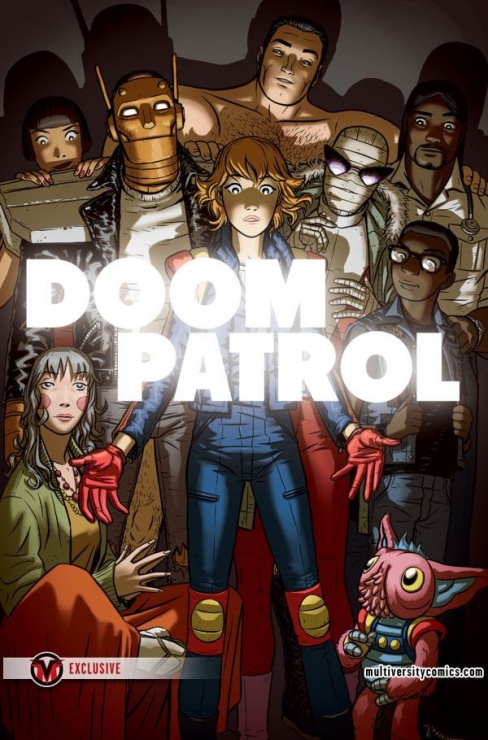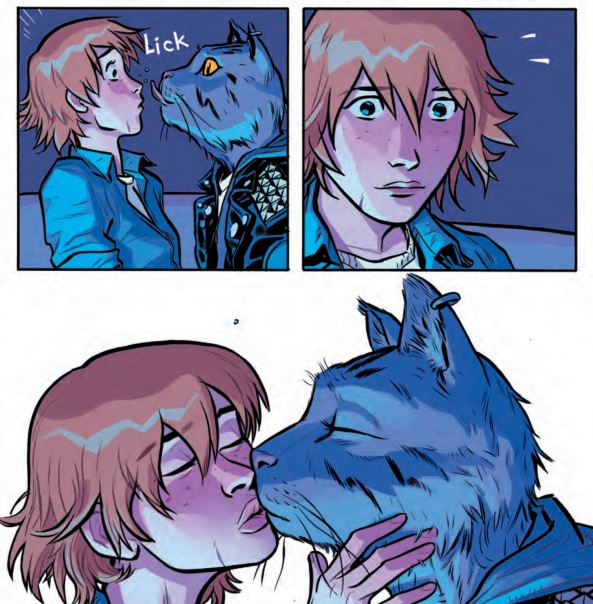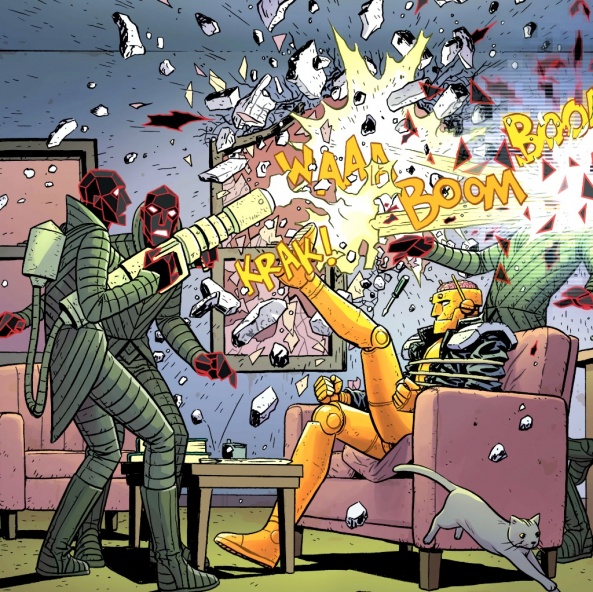There are a lot of comics out there, but some just stand out head and shoulders above the pack. With “Don’t Miss This” we want to spotlight those series we think need to be on your pull list. This week, we look at the flagship title of DC’s Young Animal imprint, “Doom Patrol.”

Who is this by?
Young Animal architect Gerard Way (My Chemical Romance frontman and writer of “The Umbrella Academy”) is the writer, and Nick Derington (“Manhunt,” Lead Animator on A Scanner Darkly) is the main artist, however, Mike and Laura Allred filled in for Issue 7. Tom Fowler inks, Tamra Bonvillain colors, and Todd Klein letters.

What’s it all about?
For the uninitiated, “Doom Patrol” was created in 1963 and follows a team made up of the “World’s Strangest Heroes,” super-powered misfits who came together to battle the enemies too bizarre for any other team.
There have been many iterations throughout the years, but this version of “Doom Patrol” predominantly takes the seminal run of Grant Morrison and Richard Case as its inspiration. Running from issues 19 – 63 of the second volume of “Doom Patrol,” Morrison and Case largely redefined the book for a new generation.
Way picks up the characters, plot threads, and tone of Morrison’s run almost wholesale, but by injecting his own brand of off-kilter humor and penchant for the surreal, Way, along with Derington and the team, have gone a long way to making this book their own.

What makes it so great?
“It’s time to fight back, it’s time to join the Doom Patrol.”
On one hand, it might be difficult to recommend this book to anyone who hasn’t read Morrison and Case’s masterful “Doom Patrol” run from 1989-1993, as Way’s approach to the team is so obviously influenced by that series of issues it’s difficult to fully separate the two. There are many references and characters in here that call back to that run, but it’s never actually overwhelming or even super relevant for new readers, so arguably you could. and should, dive straight in.
The wonderful nature of Way’s writing — evident in his “Umbrella Academy” series — is he doesn’t spoon-feed the reader. This isn’t a series you can half read, or skim through on the shelf to get the gist, this is a book with a pace, a structure, and a complexity that demands your full attention. Again, the hand of Morrison hovers over that sentiment, but either way, there’s a sense that no amount of prior reading is going to lead to you feeling completely at home in your surroundings. This is a funhouse mirror of a book, an old house that looks entirely familiar until you start measuring it up and you realize the floor is slanted and there’s not a right angle in the entire place.
“To burn against the darkness of this universe, I’d give you everything.”
“Doom Patrol” is a book that delights in subverting your narrative expectations, leading you through a maze but moving the walls around you as you go. This is a book about Casey Brinke, a free-spirited ambulance driver, except she’s not who or even what you think she is, and that ambulance-shaped vehicle she’s driving isn’t actually an ambulance, and this book isn’t entirely about her at all. However, by following her, we begin to join together the pieces of a larger mystery that requires reforming of the titular team. Through Casey, her colleague and friend Sam, and her mysterious new roommate Terry None we begin on a journey down a twisted rabbit-hole at a pace so fast that things like ‘sense’ and ‘reason’ become fleeting blurs eluding your grasp.

The first arc of “Doom Patrol,” entitled ‘Brick by Brick,’ is very much all about getting the band back together. Along the way, she meets (and sort of collects) the members of Doom Patrol, including Robotman; Larry Trainer, the Negative Man; Flex Mentallo; Jane (no longer called ‘Crazy Jane’ for obvious reasons); and even Danny The Street, the sentient street that’s now so much more.

Providing a stark, deliberate contrast to the convoluted, sometimes unfathomable plot is the gorgeous artwork of Derington and Bonvillain, who produce frankly outstanding cartooning with defined, clean lines and real emotional depth. Derington is a master of layouts. Each page, each panel is almost lyrical in its movement through the narrative, and while the plot may tie even the most observant of readers in knots, Derington’s beautiful linework and keen sense of structure will draw you in making you wonder why he doesn’t just draw every comic ever. (Artists don’t need sleep, free time, or a life, right?)
Continued belowSimilarly, Bonvillain’s colors practically sing, elevating the entire book into a stratosphere all of its own. This is a bright, fun, optimistic adventure book, and the bold, rich palette of the main narrative is contrasting and ultimately emphasized by those moments where Bonvillain switches up the palette entirely, like in Issue one where we see an alien world within a gyro. In these panels, the linework is sketchier and the colors are more washed out, almost like they’re done with pencils. In Issue 3, there’s a whole section that takes place within a comic book, and again Bonvillain’s colors shift away from the rich boldness of the main narrative and instead adopt a style reminiscent of the four-color days of the past.
”Friends help you write the fiction you want to be.”
“Doom Patrol” is a book about strange characters, a book defined by its oddness, so it makes sense that the narrative structure would follow suit. Way isn’t so much doing ‘weird for weird’s sake,’ but rather he’s introducing a controlled chaos into the flow of the book in order to instill that sense of strangeness within the very fabric of the story.

We switch all too quickly from one thread to the next without any true context, but there’s never a sense that you’re getting lost. Instead, you’re seeing everything you need to see when you need to see it. Things may not always make sense, but that never stops the Doom Patrol, and that shouldn’t stop you. Instead, if you let yourself get swept up in the adventure, you’ll find that there really is a plan all along, and things will all start to come together. It’s still strange and chaotic and oh so odd, but it wouldn’t be “Doom Patrol” if it was anything else.

How can you read it?
The first volume, ‘Brick by Brick,’ collects the first six issues and is available now either digitally or in your local comic shop. Volume two isn’t out until 2018, but the single issues have been released up to issue nine which comes out today.






